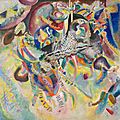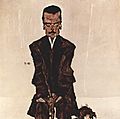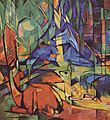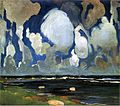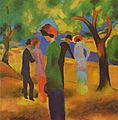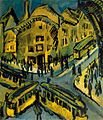Expressionism facts for kids
Expressionism is a special kind of art and cultural movement from the 20th century. Artists who were part of this movement wanted to show their feelings and emotions in their work. Instead of painting things exactly as they look, they used colors and shapes to express how they felt about the world.
This art style started as a new and experimental movement in painting and poetry before the First World War. It became very popular in the 1920s, especially in Berlin, Germany.
Contents
What is Expressionism?
Expressionism shows the world in a very personal way. It's about how the artist feels things, not just how they look. The art tries to create a strong emotional effect on the viewer. It shares the artist's own moods and ideas. Expressionist artists wanted to show what it felt like to be alive. They focused on emotional experiences rather than just physical reality.
Where You Can Find It
Expressionism appeared in many different types of art. You can see it in:
- Painting
- Literature (books and poems)
- Theatre (plays)
- Dance
- Film
- Architecture (buildings)
- Music
The word "expressionism" often suggests strong feelings, sometimes even worry or sadness. While some older painters like El Greco showed similar styles, the term "Expressionism" usually refers to art from the 20th century.
Why It Started
Expressionism focused on each person's unique view. This was a reaction against other art styles. For example, naturalism tried to show things exactly as they were. Impressionism focused on light and color, capturing a moment. Expressionists wanted to go deeper and show inner feelings.
The First World War had a big impact on artists. Many young men died, and this left deep feelings in the minds of artists. Their art often showed these strong emotions.
Famous Expressionist Artists
Some well-known modern expressionist artists include:
- Edvard Munch (famous for The Scream)
- August Macke
- Ernst-Ludwig Kirchner
- Emil Nolde
- Marc Chagall
These artists used their art to share their inner worlds. They made art that was powerful and full of emotion.
-
Fugue by Wassily Kandinsky (1914)
-
Portrait of Eduard Kosmack by Egon Schiele
-
Rehe im Walde (Deer in the Forest) by Franz Marc
Images for kids
-
Mary Wigman, a pioneer of Expressionist dance (left), at her West Berlin studio in 1959.
-
August Macke, Lady in a Green Jacket, 1913
-
Franz Marc, Fighting Forms, 1914
-
Ernst Ludwig Kirchner, Nollendorfplatz, 1912
See also
 In Spanish: Expresionismo para niños
In Spanish: Expresionismo para niños


